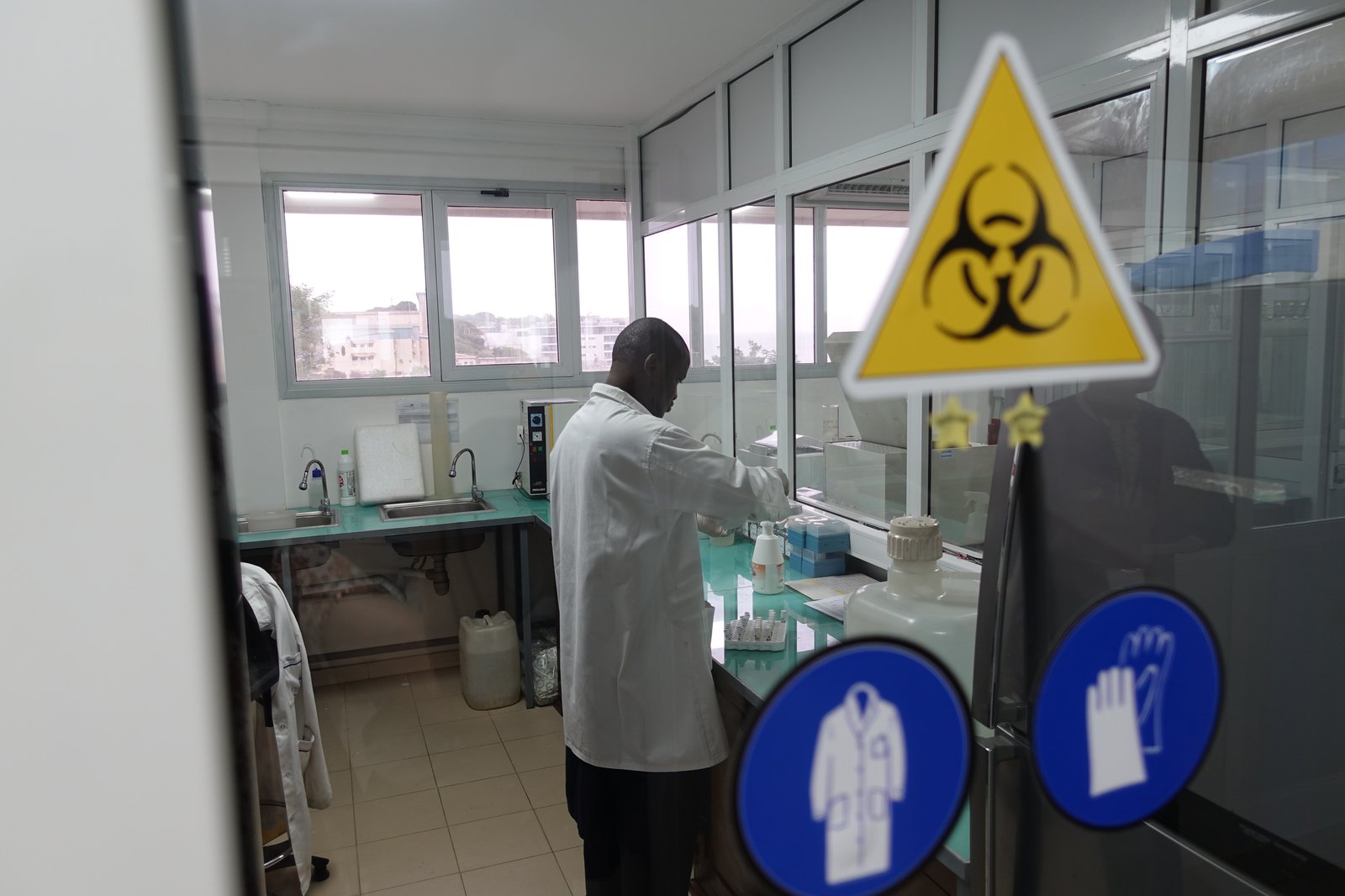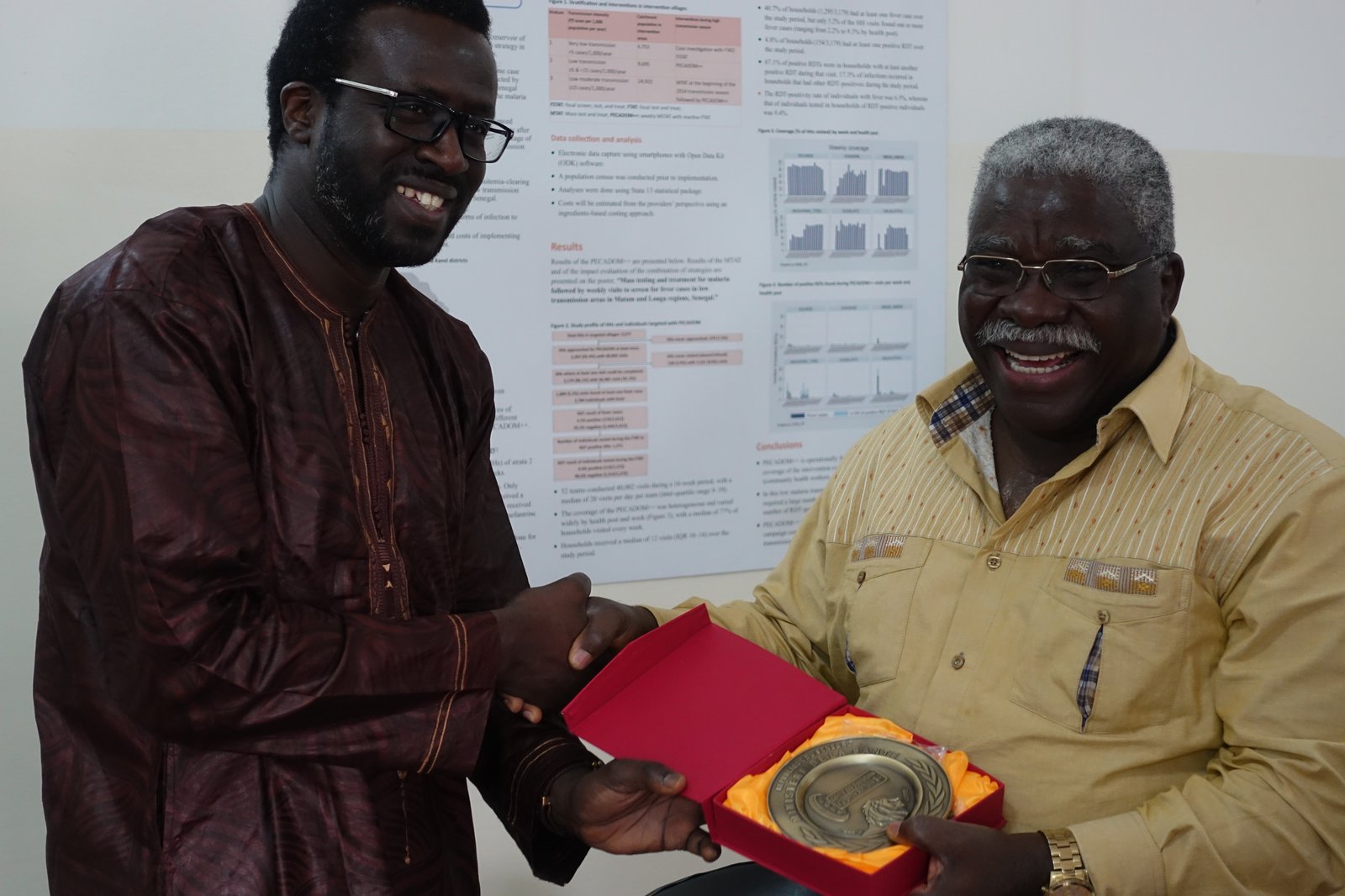In the midst of the 2014 Ebola outbreak in West Africa, a 21-year-old Guinean student came to a Dakar health clinic with symptoms of fever and diarrhea. The doctor considered Ebola, which had killed more than 1,000 people in neighboring Guinea.
But the patient wasn’t bleeding. He denied having been in contact with Ebola patients or at a burial, so the doctor determined it could be a gastrointestinal problem.
The young man got sicker. Eight days later, on August 26, 2014, he was admitted to the Centre Hospitalier Universitaire de Fann, which houses the infectious disease service. Doctors again inquired about Ebola exposure, which he denied.
Meanwhile, in Guinea, a woman reported that her brother had traveled by taxi to Senegal after the death of their uncle and burial of their brother. The Guinean Ministry of Health contacted the Senegalese Ministry with the man’s name.
“It was our patient,” recalled Dr. K.A. Daye, who led the medical team at the infectious disease service.
In this video, Dr. K.A. Daye recalls working in the hospital during the 2014 Ebola crisis. “When it comes to Ebola, you should always be scared.” Video: PATH/Lynn Heinisch.
What came next?
The staff had trained for this. They isolated the patient in a separate building behind the main hospital, confirmed with a blood test that he had the Ebola virus, and followed biosafety protocol.
They also tracked individuals who had been in contact with the patient and enacted quarantine and monitoring measures. As a result of swift and controlled action, Senegal stopped the spread of Ebola, and the patient—who survived—was the country’s only confirmed case during the outbreak.

Visiting laboratory facilities at the Institut Pasteur de Dakar. Photo: PATH/Lynn Heinisch.
Despite this victory, Senegal is not resting on this success. Health officials have used the experience to address weaknesses in the health system as part of the Global Health Security Agenda (GHSA), a partnership of more than 50 countries and organizations working to make the world safe and secure from infectious disease threats. With support from the United States Centers for Disease Control and Prevention (CDC), PATH supports GHSA programs in the Democratic Republic of the Congo (DRC) and Senegal, as well as Tanzania and Vietnam.
Over the past two years, PATH has supported the Senegalese Ministry of Health to strengthen its ability to prevent, detect, and respond to infectious disease threats by building better systems for epidemiological surveillance and laboratory testing, and supporting the creation of an emergency operations center.
“The Ebola crisis had a positive impact for Senegal,” said Dr. Abdoulaye Bousso, who leads the country’s emergency operations center, Le Centre des Opérations d’Urgence Sanitaire (COUS). “This one case showed us the gaps in the health system, and the big gap was with coordination. We have the structures, and we have all the human resources, but during a big crisis, people don’t have the habit to work together.”
Now, Senegal is sharing its learnings with other countries as they work to strengthen their ability to prevent, detect, and respond to outbreaks.

Dr. Abdoulaye Bousso, who leads Senegal’s emergency operations center presents a welcome gift to Dr. Benoit Kebela, director of the Democratic Republic of the Congo’s (DRC) Department of Disease Control. Dr. Kebela was on the front lines of the 2014 Ebola
The DRC, with technical support from PATH and CDC, is working to establish the country’s first emergency operations center. In November 2016, a delegation from the DRC, including PATH staff and officials from the country’s Ministry of Health, visited Senegal to learn how the country established COUS just two years prior. The teams met with the Senegalese Ministry of Health, COUS staff, the CDC, and the Institut Pasteur de Dakar, which partners with the government on surveillance and lab work, and tested the suspected Ebola cases.
As an indication of how pioneering this work is, it was only in 2012 that the World Health Organization established a network to identify and promote best practices and standards for emergency operations centers. “Indeed, much of the GHSA work is new and uncharted,” said Trad Hatton, PATH’s DRC program leader.
“In the field of health care, there are known standards and best practices and it’s settled, like what to do for safe childbirth,” he said. “But for global health security, we’re at the beginning of this work and it’s not yet settled. There are a lot of unknowns.”
The DRC delegation learned about budgeting and cost, establishing standard procedures, staffing, and other operational basics. As they considered the Senegal model, they debated whether a similar approach would work in their country, which has a different government structure and unique challenges. The DRC is 12 times larger than Senegal, with six times as many people, numerous borders, weak infrastructure, bears the toll of years of conflict, and has a higher poverty rate.
“Your road will be different,” acknowledged Aminata Lenormand, lab strengthening officer in Senegal. “Your reality is very different than here.”
Aminata Lenormand, a PATH employee in Senegal, describes the importance of strengthening laboratories to protect the population. Video: PATH/Lynn Heinisch.
As the teams discussed their respective experiences, Dr. Bousso urged the DRC delegation to move quickly on setting up its emergency operations center. He noted that countries like Senegal, which experienced the strain of the 2014 Ebola outbreak, may feel a greater sense of urgency than countries that did not face that crisis.
“Ebola passed, now we have Zika and it will pass,” Dr. Bousso said. “It’s important to get going because something else is coming. We are learning by doing.”
Getting stronger through learning

PATH staff from Senegal and the DRC spent a week learning from past outbreaks and planning for a more secure future. Pictured here: PATH staff from Senegal and the DRC, the DRC Ministry of Health, and the Institut Pasteur de Dakar. Photo: PATH/Lynn Heinis
Leon Kapenga, deputy director for PATH in the DRC, cited the country’s 2016 yellow fever outbreak. In one of Africa’s largest vaccination campaigns, nearly 8 million people in the capitol city of Kinshasa were vaccinated in just ten days.
“We broke the epidemic,” Kapenga said. “That’s a really big achievement with minimal doses of yellow fever vaccine and a city of roughly 11 million inhabitants. But this epidemic threatened us all and still it took time [to respond]. That is why we are here to discuss the global security work . . . we could have had a catastrophe.”
Both countries said the exchange was valuable not only for global health security but for tackling long-standing health challenges. Epidemics can “paralyze” the health system, jeopardizing lives as efforts are diverted from other vital health services. Strengthening surveillance, labs, data quality, and other core elements of a health system will yield far-reaching benefits, and improve a country’s ability to prevent, detect, and respond to emergencies.
“This was a great opportunity for the DRC to learn from Senegal, but also for Senegal to learn from the DRC. I hope that this is the first step for a much longer and deeper collaboration for our two countries,” said Philippe Guinot, PATH country manager in Senegal. “We share a lot of the health challenges in the region . . . GHSA is one opportunity [for PATH to serve] as a catalyst for change and sharing information.”
This blog post and the activities described therein were supported by Cooperative Agreement Number 1U2GGH001812-01, funded by the Centers for Disease Control and Prevention. Its contents are solely the responsibility of the authors and do not necessarily represent the official views of the Centers for Disease Control and Prevention or the Department of Health and Human Services.
